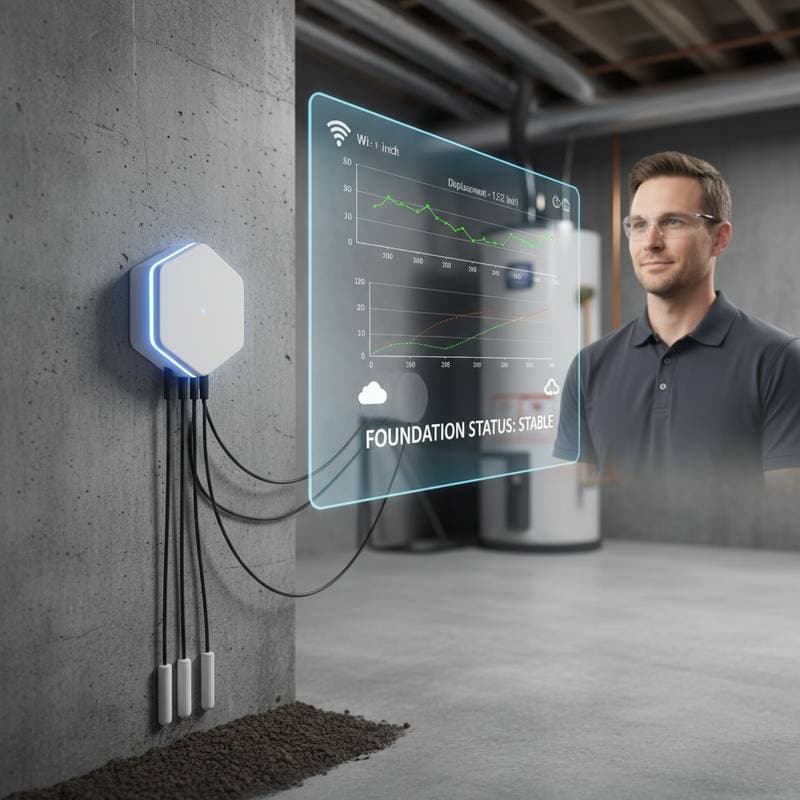Smart Sensors Identify Foundation Settling Before Visible Damage
Foundation movement ranks among the costliest issues homeowners encounter. A small crack or a door that sticks may signal the start of uneven floors, separating walls, or broader instability. Smart foundation sensors empower property owners to spot these shifts early, well before problems escalate. This guide details sensor functionality, pricing, and incorporation into a comprehensive maintenance strategy.
Key Takeaways
- Cost Breakdown: Systems range from $800 to $2,500, with hardware accounting for 60 percent, installation 30 percent, and software subscriptions 10 percent.
- Precision Levels: Sensors detect movements as fine as 1/32 inch and tilt variations up to 0.1 degrees.
- Setup Duration: Installation typically requires 2 to 4 hours, with limited impact on daily routines.
- Connectivity Needs: Systems depend on stable Wi-Fi or cellular connections, plus uninterrupted power, often with battery backups.
- Selection Criteria: Consider soil composition, local climate, and foundation type to optimize sensor placement and configuration.
Functionality of Smart Foundation Sensors
These sensors integrate accelerometers, tilt meters, and moisture probes to track movement, vibrations, and surrounding conditions. Data flows to a central hub, which relays information to a mobile app or online dashboard.
Sensors monitor several factors continuously:
- Vertical Shifts: They register slight sinking or uplifting in slabs or footings.
- Angular Changes: Devices capture rotations or tilts in the structure's alignment.
- Soil Moisture Levels: Probes record variations that lead to soil swelling or shrinking.
- Thermal Effects: Units observe temperature swings influencing material expansion.
Alerts trigger when data surpasses defined limits, signaling potential settling prior to any outward signs. This immediate insight enables timely inspections or adjustments, sidestepping the need for reactive fixes after cracks emerge.
Essential Materials and Tools
Prepare the following for effective setup:
- Sensors: Select units offering ±0.1-degree accuracy in durable, weatherproof casings.
- Hub or Gateway: This component links sensors and uploads data to cloud storage.
- Mounting Supplies: Opt for stainless steel fasteners or adhesives compatible with concrete and wood surfaces.
- Power Sources: Include battery packs or low-voltage wiring designed for outdoor endurance.
- Monitoring Interface: Access real-time alerts and trend reviews via app or browser.
- Protective Gear: Use gloves, safety glasses, and masks during any drilling or prep work.
Analyzing Data for Reliable Insights
Consistent review ensures accurate trend identification. Examine readings weekly in the initial months, then shift to monthly checks as baselines solidify. Focus on these indicators:
- Cumulative shifts surpassing 1/8 inch across multiple measurements.
- Tilt adjustments exceeding 0.2 degrees on repeated occasions.
- Moisture swings greater than 10 percent within brief periods.
Upon detecting anomalies, examine the site for erosion, leaks, or poor drainage. Modify alert settings only after verifying the underlying factors.
Ensuring Longevity and Optimal Operation
These sensors demand little upkeep, yet routine checks prevent issues. Clear away debris or webs that could interfere with signals. Apply manufacturer firmware updates to bolster functionality and protection.
Maintain records of alerts, calibrations, and external influences. Such documentation reveals ongoing patterns and informs precise upkeep schedules.
Choosing Between DIY and Expert Installation
Homeowners skilled in wiring and app configuration can handle installation independently, potentially reducing labor expenses by 20 to 40 percent. For homes with existing movement indicators or on swelling clay soils, engage professionals. Experts calibrate sensors accurately and contextualize data against the structure's specifics. Confirm that any hired team holds proper licensing, insurance, and expertise in monitoring technologies.
Strategies for Effective Implementation
- Secure sensors to load-bearing components, avoiding non-structural finishes.
- Label each unit clearly and map its position for easy reference.
- Link notifications to smart home platforms for instant updates.
- Pair moisture detection with enhanced drainage to amplify safeguards.
- Arrange yearly expert evaluations to confirm data integrity.
Safeguarding Structural Integrity with Advanced Monitoring
Smart foundation sensors provide homeowners with tools to maintain stability proactively. Early detection of ground shifts and environmental factors facilitates interventions that avert cracks and major expenditures. Integrated into broader smart systems or used alone, these devices shift foundation management toward prevention. Through diligent setup, periodic adjustments, and data-driven decisions, owners secure their properties against long-term risks.
